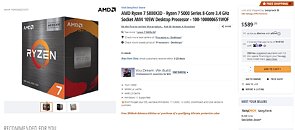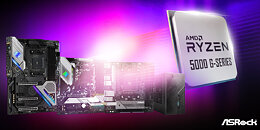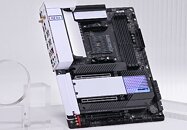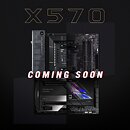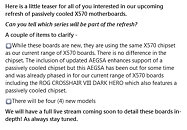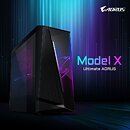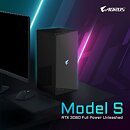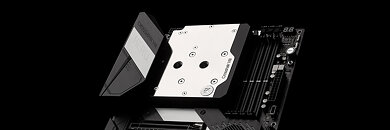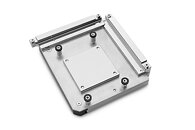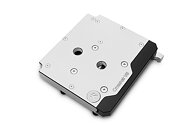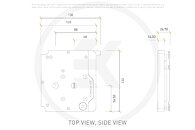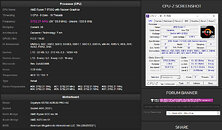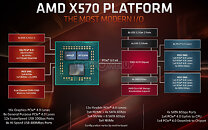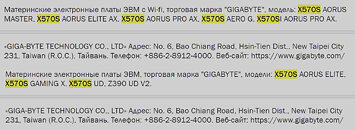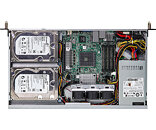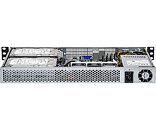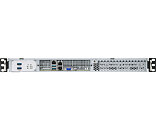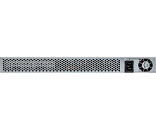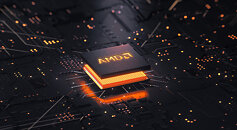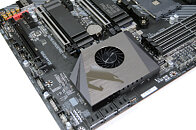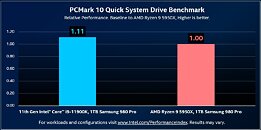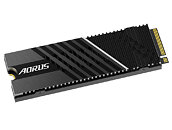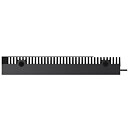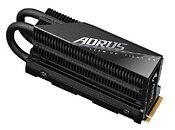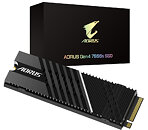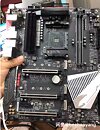Apr 18th, 2025 15:33 EDT
change timezone
Latest GPU Drivers
New Forum Posts
- Can Intel recover in DYI market anytime soon? (9)
- Place your bets, what node will rtx 6000/RDNA 5(UDNA 1?) use (7)
- GPU Pricing and Performance (15)
- What are you playing? (23396)
- TPU's Nostalgic Hardware Club (20256)
- Spoofer Modified SMBIOS/BIOS – Need Help Restoring Original Motherboard Info (TUF GAMING B550-PLUS WiFi II) (2)
- Tried installing 576.02 - installer window disappears (20)
- RX 9000 series GPU Owners Club (392)
- GPU Database (300)
- Drives fail to work with Rufus Windows TO GO (2)
Popular Reviews
- ASUS GeForce RTX 5060 Ti TUF OC 16 GB Review
- NVIDIA GeForce RTX 5060 Ti PCI-Express x8 Scaling
- Palit GeForce RTX 5060 Ti Infinity 3 16 GB Review
- G.SKILL Trident Z5 NEO RGB DDR5-6000 32 GB CL26 Review - AMD EXPO
- ASUS GeForce RTX 5060 Ti Prime OC 16 GB Review
- Teevolution Terra Pro Review
- MSI GeForce RTX 5060 Ti Gaming OC 16 GB Review
- Zotac GeForce RTX 5060 Ti AMP 16 GB Review
- MSI GeForce RTX 5060 Ti Gaming Trio OC 16 GB Review
- ASUS GeForce RTX 5080 TUF OC Review
Controversial News Posts
- NVIDIA GeForce RTX 5060 Ti 16 GB SKU Likely Launching at $499, According to Supply Chain Leak (182)
- NVIDIA Sends MSRP Numbers to Partners: GeForce RTX 5060 Ti 8 GB at $379, RTX 5060 Ti 16 GB at $429 (127)
- Nintendo Confirms That Switch 2 Joy-Cons Will Not Utilize Hall Effect Stick Technology (105)
- Over 200,000 Sold Radeon RX 9070 and RX 9070 XT GPUs? AMD Says No Number was Given (100)
- Nintendo Switch 2 Launches June 5 at $449.99 with New Hardware and Games (99)
- NVIDIA Launches GeForce RTX 5060 Series, Beginning with RTX 5060 Ti This Week (98)
- Sony Increases the PS5 Pricing in EMEA and ANZ by Around 25 Percent (85)
- NVIDIA PhysX and Flow Made Fully Open-Source (77)
News Posts matching #X570
Return to Keyword Browsing
AMD Patches Zenbleed Vulnerability with AGESA 1.2.0.Ca Update
AMD classified the Zenbleed vulnerability, CVE-2023-20593, as a medium-level threat about a year ago. AMD has acknowledged that it could potentially allow an attacker to access sensitive information under certain microarchitectural circumstances. Today, MSI has released new BIOS updates featuring AMD's AM4 AGESA 1.2.0.Ca firmware update. This update addresses the Zenbleed vulnerability affecting AMD's Ryzen 4000 series Zen 2 APUs. MSI is proactively rolling out the new BIOS updates across its range of compatible motherboards. The updates are currently available for almost all X570 motherboards, with support for other chipsets and 400 series motherboards expected to follow soon.
The AGESA 1.2.0.Ca firmware update specifically targets the Zenbleed vulnerability in the Zen 2 microarchitecture. Although the vulnerability primarily affects Ryzen 4000 "Renoir" APUs, it also exists in other Zen 2 processors, including the Ryzen 3000 series and certain EPYC and Threadripper CPUs. AMD has already addressed the Zenbleed vulnerability in previous AGESA microcode updates for Ryzen 3000 processors and other platforms, such as EPYC server CPUs and Ryzen mobile CPUs. However, the Ryzen Embedded V2000 CPUs are still awaiting the EmbeddedPi-FP6 1.0.0.9 AGESA firmware update, which is expected to be released by April. While AMD has not explicitly stated whether the security update will impact performance, previous testing of Zenbleed fixes has shown potential performance drops of up to 15% in certain workloads, although gaming performance remained relatively unaffected. Users with AM4 chips based on architectures other than Zen 2, such as Zen+ or Zen 3, do not need to update their BIOS as they are not affected by this specific vulnerability.
The AGESA 1.2.0.Ca firmware update specifically targets the Zenbleed vulnerability in the Zen 2 microarchitecture. Although the vulnerability primarily affects Ryzen 4000 "Renoir" APUs, it also exists in other Zen 2 processors, including the Ryzen 3000 series and certain EPYC and Threadripper CPUs. AMD has already addressed the Zenbleed vulnerability in previous AGESA microcode updates for Ryzen 3000 processors and other platforms, such as EPYC server CPUs and Ryzen mobile CPUs. However, the Ryzen Embedded V2000 CPUs are still awaiting the EmbeddedPi-FP6 1.0.0.9 AGESA firmware update, which is expected to be released by April. While AMD has not explicitly stated whether the security update will impact performance, previous testing of Zenbleed fixes has shown potential performance drops of up to 15% in certain workloads, although gaming performance remained relatively unaffected. Users with AM4 chips based on architectures other than Zen 2, such as Zen+ or Zen 3, do not need to update their BIOS as they are not affected by this specific vulnerability.

AMD Unveils 5 nm Ryzen 7000 "Zen 4" Desktop Processors & AM5 DDR5 Platform
AMD today unveiled its next-generation Ryzen 7000 desktop processors, based on the Socket AM5 desktop platform. The new Ryzen 7000 series processors introduce the new "Zen 4" microarchitecture, with the company claiming a 15% single-threaded uplift over "Zen 3" (16-core/32-thread Zen 4 processor prototype compared to a Ryzen 9 5950X). Other key specs about the architecture put out by AMD include a doubling in per-core L2 cache to 1 MB, up from 512 KB on all older versions of "Zen." The Ryzen 7000 desktop CPUs will boost to frequencies above 5.5 GHz. Based on the way AMD has worded their claims, it seems that the "+15%" number includes IPC gains, plus gains from higher clocks, plus what the DDR4 to DDR5 transition achieves. With Zen 4, AMD is introducing a new instruction set for AI compute acceleration. The transition to the LGA1718 Socket AM5 allows AMD to use next-generation I/O, including DDR5 memory, and PCI-Express Gen 5, both for the graphics card, and the M.2 NVMe slot attached to the CPU socket.
Much like Ryzen 3000 "Matisse," and Ryzen 5000 "Vermeer," the Ryzen 7000 "Raphael" desktop processor is a multi-chip module with up to two "Zen 4" CCDs (CPU core dies), and one I/O controller die. The CCDs are built on the 5 nm silicon fabrication process, while the I/O die is built on the 6 nm process, a significant upgrade from previous-generation I/O dies that were built on 12 nm. The leap to 5 nm for the CCD enables AMD to cram up to 16 "Zen 4" cores per socket, all of which are "performance" cores. The "Zen 4" CPU core is larger, on account of more number-crunching machinery to achieve the IPC increase and new instruction-sets, as well as the larger per-core L2 cache. The cIOD packs a pleasant surprise—an iGPU based on the RDNA2 graphics architecture! Now most Ryzen 7000 processors will pack integrated graphics, just like Intel Core desktop processors.
Much like Ryzen 3000 "Matisse," and Ryzen 5000 "Vermeer," the Ryzen 7000 "Raphael" desktop processor is a multi-chip module with up to two "Zen 4" CCDs (CPU core dies), and one I/O controller die. The CCDs are built on the 5 nm silicon fabrication process, while the I/O die is built on the 6 nm process, a significant upgrade from previous-generation I/O dies that were built on 12 nm. The leap to 5 nm for the CCD enables AMD to cram up to 16 "Zen 4" cores per socket, all of which are "performance" cores. The "Zen 4" CPU core is larger, on account of more number-crunching machinery to achieve the IPC increase and new instruction-sets, as well as the larger per-core L2 cache. The cIOD packs a pleasant surprise—an iGPU based on the RDNA2 graphics architecture! Now most Ryzen 7000 processors will pack integrated graphics, just like Intel Core desktop processors.

AMD Ryzen 7 5800X3D Starts Selling at 30% Mark-up
The unexpected parting-shot of Socket AM4 and "Zen 3" at Intel's new "Alder Lake" architecture, the AMD Ryzen 7 5800X3D, started selling. There is, however, a rude catch. On popular US retailer Newegg, the processor is going for as high as USD $589, or $140 higher than the $449 MSRP, a 30 percent mark-up. This would also put its price a vulgar $230 higher (64 percent higher) than the Ryzen 7 5800X, a price difference that can get you a reasonably good motherboard based on the AMD X570 chipset, or perhaps even a combination of a well-priced AMD B550 chipset motherboard and 16 GB of DDR4-3600 memory. It is important to note, however, though, that the Newegg listing is fulfilled by one of its marketplace vendors, and not Newegg directly. The site isn't selling the 5800X3D through its own fulfillment inventory.
The Ryzen 7 5800X3D thoroughly impressed us and several other tech reviewers. AMD stands good on its claim that the 5800X3D is faster than the Core i9-12900K at gaming, and it does end up trading blows with the i9-12900KS (an $800 chip) in several titles. The $589 marked-up price, however, erodes much of that goodwill, and for that kind of money, you're better off just getting a Core i9-12900 (non-K), and unshackling its power limits in the motherboard BIOS. The i9-12900 will trade blows with the 5800X3D at gaming, but will thoroughly outclass it at productivity. Both the i9-12900 and the 5800X3D are "locked."
The Ryzen 7 5800X3D thoroughly impressed us and several other tech reviewers. AMD stands good on its claim that the 5800X3D is faster than the Core i9-12900K at gaming, and it does end up trading blows with the i9-12900KS (an $800 chip) in several titles. The $589 marked-up price, however, erodes much of that goodwill, and for that kind of money, you're better off just getting a Core i9-12900 (non-K), and unshackling its power limits in the motherboard BIOS. The i9-12900 will trade blows with the 5800X3D at gaming, but will thoroughly outclass it at productivity. Both the i9-12900 and the 5800X3D are "locked."

ASRock Announces Full Stack Support for Ryzen 7 5800X3D and New 5000/4000 Series Processors
The global leading motherboard manufacturer, ASRock, announces that with BIOS update, ASRock AMD X570/B550/A520/X470/B450 motherboards will support the latest AMD Ryzen 5000/4000 series processors, including Ryzen 7 5800X3D. ASRock always design ahead to get for new processors and has been working with AMD to validate the latest BIOS AGESA code. The 3D V-Cache technology of AMD Ryzen 7 5800X3D processor offers significant improvements on gaming performance, update to the latest BIOS and get ready to game with new AMD Ryzen processors.

GIGABYTE AMD Motherboards Natively Support the Latest Ryzen Desktop Processors
GIGABYTE TECHNOLOGY Co. Ltd, a leading manufacturer of motherboards, graphics cards, and hardware solutions, today announced X570, B550, A520, X470, B450, and A320 motherboards can support the newly launched Ryzen 5000 and Ryzen 4000 series processors without updating BIOS. Users can customize their system according to personal budget, performance request, and accustomed configuration to enjoy the full advantages of GIGABYTE motherboards.
The new launched AMD processors include Ryzen 7 5700X, Ryzen 5 5600, Ryzen 5 4600G and Ryzen 5 5500, Ryzen 5 4500, Ryzen 3 4100, bring users more comprehensive options with various performance and pricing segment. To fully support and unleash all advantages of the new processors, GIGABYTE X570, B550, A520, X470, B450, and A320 motherboards are shipped to market with the latest BIOS. Users can either get the optimal performance by X series motherboards with Ryzen 7 5700X processors, or build a price-competitive platform of A series motherboards with Ryzen 3 4100 processors.
The new launched AMD processors include Ryzen 7 5700X, Ryzen 5 5600, Ryzen 5 4600G and Ryzen 5 5500, Ryzen 5 4500, Ryzen 3 4100, bring users more comprehensive options with various performance and pricing segment. To fully support and unleash all advantages of the new processors, GIGABYTE X570, B550, A520, X470, B450, and A320 motherboards are shipped to market with the latest BIOS. Users can either get the optimal performance by X series motherboards with Ryzen 7 5700X processors, or build a price-competitive platform of A series motherboards with Ryzen 3 4100 processors.

EK Announces Momentum² Monoblock for ASUS ROG Strix X570-I Gaming
EK, the premium liquid cooling gear manufacturer, is releasing a new AMD AM4 socket-based monoblock belonging to the Quantum Line of products, the EK-Quantum Momentum² ROG Strix X570-I Gaming D-RGB. This monoblock is engineered specifically for the ROG Strix X570-I Gaming ITX motherboard from ASUS. The addressable D-RGB LED in the monoblock is compatible with ASUS Aura Sync RGB control and offers a full lighting customization experience for every single diode at any given time. This monoblock is EK-Matrix7 compatible.
This is a complete all-in-one (CPU and motherboard) liquid cooling solution for Ryzen AMD processors and the monoblock is compatible with the AM4 socketed ROG Strix X570-I Gaming motherboard. This monoblock uses the latest generation of EK Velocity² cooling engine to ensure the best possible CPU cooling while not reducing flow to other components. This water block directly cools the AM4 Ryzen CPU, VRM section, and importantly the X570 Chipset which tends to run quite hot. This eliminates the need for any fans on the motherboard.
This is a complete all-in-one (CPU and motherboard) liquid cooling solution for Ryzen AMD processors and the monoblock is compatible with the AM4 socketed ROG Strix X570-I Gaming motherboard. This monoblock uses the latest generation of EK Velocity² cooling engine to ensure the best possible CPU cooling while not reducing flow to other components. This water block directly cools the AM4 Ryzen CPU, VRM section, and importantly the X570 Chipset which tends to run quite hot. This eliminates the need for any fans on the motherboard.

EVGA Announces X570 FTW WiFi Motherboard
EVGA today rolled out the X570 FTW WiFi, its second AMD Socket AM4 motherboard. While the X570 DARK is aimed at professional overclockers looking to squeeze the most out of Ryzen 5000 series processors, the X570 FTW is aimed at a slightly broader audience—enthusiasts. The board comes with four DDR4 DIMM slots to illustrate this, compared to two slots (1 DIMM per channel) on the X570 DARK. The board pulls power from a combination of 24-pin ATX, and 8+4 pin EPS. It features a 15-phase CPU VRM that's cooled by aluminium fin-stack heatsinks. The Socket AM4 processor is wired to four DDR4 DIMM slots, two PCI-Express 4.0 x16 (x8/x8 with both populated), and an M.2 NVMe slot with PCI-Express 4.0 x4 wiring.
Besides this CPU-attached M.2 NVMe Gen 4 slot, two additional Gen 4 slots are put out by the X570 chipset, cooled by a large aluminium monoblock heatsink. The X570 chipset itself is cooled fanless, which means it's likely the X570S variant. Eight SATA 6 Gbps ports make for the rest of the storage connectivity. USB connectivity includes three 10 Gbps USB 3.1 Gen2 ports at the rear panel, two 5 Gbps Gen1 ports, and two additional Gen1 ports through internal headers. The onboard audio solution uses a Realtek ALC1220 CODEC with SV3H615 headphones amp. Networking connectivity includes Intel-sourced WiFi 6 and 1 GbE. Available to EVGA Elite members, the EVGA X570 FTW WiFi is priced at USD $499, about $200 cheaper than the X570 DARK.
Besides this CPU-attached M.2 NVMe Gen 4 slot, two additional Gen 4 slots are put out by the X570 chipset, cooled by a large aluminium monoblock heatsink. The X570 chipset itself is cooled fanless, which means it's likely the X570S variant. Eight SATA 6 Gbps ports make for the rest of the storage connectivity. USB connectivity includes three 10 Gbps USB 3.1 Gen2 ports at the rear panel, two 5 Gbps Gen1 ports, and two additional Gen1 ports through internal headers. The onboard audio solution uses a Realtek ALC1220 CODEC with SV3H615 headphones amp. Networking connectivity includes Intel-sourced WiFi 6 and 1 GbE. Available to EVGA Elite members, the EVGA X570 FTW WiFi is priced at USD $499, about $200 cheaper than the X570 DARK.

BIOSTAR Brings AMD Cezanne Support to Motherboards Using BIOS Update
BIOSTAR, a leading brand of motherboards, graphics cards, and storage devices, today announced product support for the latest AMD Ryzen 5000G series Cezanne processors. AMD's next-generation Ryzen 5000G series desktop processors codenamed "Cezanne" are ready to invade the global market. The new 5000G series processors are based on Zen 3 architecture, AMD's Ryzen 5000 series of desktop APUs based on the Zen 3 CPU and Vega GPU microarchitectures succeeding the Ryzen 4000 "Renoir" series.
Extreme performance enabled for personal computing with up to 8 cores fueled by the world's most advanced 7 nm processor core technology, the AMD Ryzen 5000 G-series desktop processors with Radeon graphics deliver ultra-fast responsiveness and multi-threaded performance for any use case.
Extreme performance enabled for personal computing with up to 8 cores fueled by the world's most advanced 7 nm processor core technology, the AMD Ryzen 5000 G-series desktop processors with Radeon graphics deliver ultra-fast responsiveness and multi-threaded performance for any use case.

EVGA X570 DARK Motherboard Pictured, Fully Loaded
Here's the first picture of a production EVGA X570 DARK motherboard, the company's flagship Socket AM4 motherboard targeting overclocking features on the latest "Zen 3" processors. The board prioritizes CPU and memory overclocking headroom above all else. The orientation of the Socket AM4 is rotated 240°, such that the memory slots are located on top of the socket. There's only 1 DIMM per memory channel, which is the most optimal topology for memory overclocking. The angled power inputs, along with onboard buttons, switches, POST code display, and voltage measurement points, are conveniently located in the top-right corner of the PCB, with the power inputs being angled to reduce cable clutter.
The CPU socket is wired to two PCI-Express 4.0 x16 slots (x8/x8 with both populated), and an M.2 NVMe slot with PCI-Express 4.0 x4 wiring. The X570 chipset (not specified whether it's an X570S), is cooled passively, by a large heatsink that extends into heatsink over the board's two M.2 slots. Connectivity likely includes two wired networking interfaces, a Wi-Fi 6E wireless interface, and EVGA's highest-grade onboard audio solution. The board's BIOS is optimized for record-breaking CPU and memory overclocking, using sub-zero cooling solutions. The company didn't reveal availability or pricing.
The CPU socket is wired to two PCI-Express 4.0 x16 slots (x8/x8 with both populated), and an M.2 NVMe slot with PCI-Express 4.0 x4 wiring. The X570 chipset (not specified whether it's an X570S), is cooled passively, by a large heatsink that extends into heatsink over the board's two M.2 slots. Connectivity likely includes two wired networking interfaces, a Wi-Fi 6E wireless interface, and EVGA's highest-grade onboard audio solution. The board's BIOS is optimized for record-breaking CPU and memory overclocking, using sub-zero cooling solutions. The company didn't reveal availability or pricing.

ASUS Launches STRIX-E, ProArt Creator and TUF Pro AMD X570 Motherboards
ASUS today introduced a trio of new motherboards based on AMD's X570 chipset, which join the latest ROG Crosshair VIII Extreme as the latest offerings from ASUS on the X570 platform.
The ROG Strix X570-E Gaming WiFi II pairs the latest tech with essential ROG DNA
Elite gamers and enthusiasts who prefer the finer things in life will want to take a look at the new ROG Strix X570-E Gaming WiFi II. Building on the legacy of the ROG Strix X570-E Gaming WiFi before it, this fresh new board distills high-end components, smart software, and passive chipset cooling into one luxurious board. This revision of the X570-E makes a splash with revised ROG graphics running across the I/O shroud and the chipset heatsink. The CPU VRM also gets a boost to a 12+4-phase design, fueled by ProCool II auxiliary connectors. No matter your choice of Ryzen CPU, the new Strix-E will handle it with aplomb.
The ROG Strix X570-E Gaming WiFi II pairs the latest tech with essential ROG DNA
Elite gamers and enthusiasts who prefer the finer things in life will want to take a look at the new ROG Strix X570-E Gaming WiFi II. Building on the legacy of the ROG Strix X570-E Gaming WiFi before it, this fresh new board distills high-end components, smart software, and passive chipset cooling into one luxurious board. This revision of the X570-E makes a splash with revised ROG graphics running across the I/O shroud and the chipset heatsink. The CPU VRM also gets a boost to a 12+4-phase design, fueled by ProCool II auxiliary connectors. No matter your choice of Ryzen CPU, the new Strix-E will handle it with aplomb.

ASRock New BIOS Updates To Support AMD Ryzen 5000 G-Series Desktop Processors with Radeon Graphics
The leading global motherboard, graphics card, and small form factor PC manufacturer, ASRock, has released the latest BIOS that support AMD Ryzen 5000 G-Series Desktop Processors with Radeon Graphics and AMD Ryzen 5000 Series Desktop Processors with PRO Technologies.
AMD Ryzen 5000 G-Series Desktop Processors with Radeon Graphics are the newest generation processors come with industry-leading 7nm technology, elevating processing performance to the next level. And now, ASRock 500-Series, B450 AMD Ryzen motherboards and X300 Mini PC are able to support both of them by updating the latest BIOS.
AMD Ryzen 5000 G-Series Desktop Processors with Radeon Graphics are the newest generation processors come with industry-leading 7nm technology, elevating processing performance to the next level. And now, ASRock 500-Series, B450 AMD Ryzen motherboards and X300 Mini PC are able to support both of them by updating the latest BIOS.

GIGABYTE Readies X570S AERO G Motherboard
GIGABYTE is giving finishing touches to its new motherboard targeted at creators who like to game, and premium desktop builders, the X570S AERO G. This marks the debut of the company's AERO brand, associated with notebooks, over to the desktop PC components segment. The board's aesthetics appear more in line with the company's VISION line of products. The Socket AM4 motherboard is based on the new AMD X570S chipset, a low-power version of the X570 that can make do with fanless cooling.
What sets the X570S AERO G apart is its five M.2 NVMe Gen 4 slots, leveraging the PCIe Gen 4 downstream connectivity of the X570S. You also get two PCI-Express 4.0 x16 slots (x8/x8 with both populated), and creator-relevant connectivity that includes 2.5 GbE wired LAN, Wi-Fi 6E, and GIGABYTE's highest onboard audio grade. Thunderbolt connectivity is unlikely to be found. The board will come with out-of-the-box support not just for Ryzen 5000 "Vermeer" processors, but also Ryzen 5000G "Cezanne" APUs, which it wires out through DisplayPort and HDMI ports.
Update Jul 5th: GIGABYTE formally launched the X570S AERO G. It lacks 10 GbE, unlike previously reported, offers 2.5 GbE, and comes with USB 3.2x2 (20 Gbps) ports.
What sets the X570S AERO G apart is its five M.2 NVMe Gen 4 slots, leveraging the PCIe Gen 4 downstream connectivity of the X570S. You also get two PCI-Express 4.0 x16 slots (x8/x8 with both populated), and creator-relevant connectivity that includes 2.5 GbE wired LAN, Wi-Fi 6E, and GIGABYTE's highest onboard audio grade. Thunderbolt connectivity is unlikely to be found. The board will come with out-of-the-box support not just for Ryzen 5000 "Vermeer" processors, but also Ryzen 5000G "Cezanne" APUs, which it wires out through DisplayPort and HDMI ports.
Update Jul 5th: GIGABYTE formally launched the X570S AERO G. It lacks 10 GbE, unlike previously reported, offers 2.5 GbE, and comes with USB 3.2x2 (20 Gbps) ports.

Western Digital Readies WD Black SN850 Firmware Update Restoring AMD X570 Performance
Western Digital is reportedly preparing a firmware update for its WD Black SN850 M.2 NVMe SSD that restores the drive's write performance levels on PCs based on the AMD X570 platform. This problem is localized to X570, specifically to when the drive is installed on an M.2 NVMe slot that is wired to the X570 chipset. Drives that are installed on the slot that's directly wired to the Ryzen processor perform as expected (Ryzen 3000 "Matisse" and Ryzen 5000 "Vermeer").
The drive performs as intended on AMD B550, as well as Intel platforms that support PCIe Gen 4, as the only Gen 4-capable M.2 slots are the ones directly wired to the processor. Western Digital localized the problem to certain X570 motherboards that have their PCIe maximum payload size (MPS) value set at 128 bytes. This dictates the maximum transaction layer packet (TLP) that goes through the PCIe controller, and a low MPS value cripples performance. The firmware update by Western Digital possibly works around this limitation. The company is expected to release the firmware update by 12 July, 2021.
The drive performs as intended on AMD B550, as well as Intel platforms that support PCIe Gen 4, as the only Gen 4-capable M.2 slots are the ones directly wired to the processor. Western Digital localized the problem to certain X570 motherboards that have their PCIe maximum payload size (MPS) value set at 128 bytes. This dictates the maximum transaction layer packet (TLP) that goes through the PCIe controller, and a low MPS value cripples performance. The firmware update by Western Digital possibly works around this limitation. The company is expected to release the firmware update by 12 July, 2021.

ASUS Teases Four Upcoming X570 Motherboards with Fanless Chipset Cooling
ASUS teased what is possibly its final round of Socket AM4 motherboards based on the AMD X570 chipset. The boards are based on the X570 chipset with the latest AGESA update that runs the chipset cooler, so thay can made do with fanless heatsink cooling. The teaser pic reveals at least four models—one based in the coveted ProArt line of creator motherboards; one from the TUF Gaming line of value-ended gaming motherboards; one form the ROG Strix series of premium gaming motherboards; and the last from the ROG Crosshair series of enthusiast/overclocking motherboards.
The motherboard in the bottom-right quadrant isn't the Crosshair VIII Dark Hero, but very likely a next-gen Crosshair Formula product. The bottom-left board could be a successor to the ROG Strix X570-E Gaming. The top-right board could be a TUF Gaming X570 Pro successor; while the top-left could be an all new product based in the ProArt series.
Update May 31st: ASUS clarified in a Facebook post that these motherboards use the same X570 chipset, but take advantage of the latest AGESA firmware that lowers TDP of the chipset just enough for motherboard designers to use fanless heatsinks.
The motherboard in the bottom-right quadrant isn't the Crosshair VIII Dark Hero, but very likely a next-gen Crosshair Formula product. The bottom-left board could be a successor to the ROG Strix X570-E Gaming. The top-right board could be a TUF Gaming X570 Pro successor; while the top-left could be an all new product based in the ProArt series.
Update May 31st: ASUS clarified in a Facebook post that these motherboards use the same X570 chipset, but take advantage of the latest AGESA firmware that lowers TDP of the chipset just enough for motherboard designers to use fanless heatsinks.

GIGABYTE Unleashes the AORUS Gen 4 7000s Prem. SSD
GIGABYTE Technology, one of the top global manufacturers of motherboards, graphics cards, and hardware solutions, announces today the latest AORUS Gen4 7000s Prem. SSD with up to 7 GB/s read speed while optimizing passive thermal dissipation, which promises no throttling under long-lasting operation. Through the SSD Tool Box application, users can have an instant control on overall operation of SSD.
AORUS Gen4 7000s Prem. SSD adopts the PCIe 4.0 NVMe M.2 interface and it equips the latest Phison E18 selected 8-channel controller, which provides users with ultimate random access rate, as well as the high speed 3D-TLC NAND Flash and SLC cache design that brings the PCIe 4.0 into full play. With the read speed up to 7 GB/s and write speed up to 6.85 GB/s, AORUS Gen4 7000s Prem. SSD can power up content creators, gamers, and users eager for extreme performance.
AORUS Gen4 7000s Prem. SSD adopts the PCIe 4.0 NVMe M.2 interface and it equips the latest Phison E18 selected 8-channel controller, which provides users with ultimate random access rate, as well as the high speed 3D-TLC NAND Flash and SLC cache design that brings the PCIe 4.0 into full play. With the read speed up to 7 GB/s and write speed up to 6.85 GB/s, AORUS Gen4 7000s Prem. SSD can power up content creators, gamers, and users eager for extreme performance.

GIGABYTE Also Announces AORUS Model X and Model S Gaming PCs Powered By AMD Ryzen Processors
GIGABYTE TECHNOLOGY Co. Ltd, a leading manufacturer of motherboards and graphics cards, today presented two gaming systems of AMD X570 platform with AORUS MODEL X and AMD B550 platform with mini system AORUS MODEL S, which adopt the top-notch components and materials for extreme performance. Enhanced by the strict verification and leading technology, GIGABYTE provides the PC system of extreme performance with optimized heat dissipation and acoustic control. The system maintains cool and quiet even under the full operation, which balance the high performance and low temperature to keep the system acoustic under 40dB without throttling. Furthermore, the three-year warranty of full system offers an ease and comprehensive service for users.
"When tackling the uplift of PC performance, multi-core, high frequency, and copious storage become a must to the premium PC platform, as well as how to make the best components matrix to provide the optimized performance with reliability turns into more inevitable." indicated by Eddie Lin, Vice President of the GIGABYTE Channel Solutions. "The new AORUS system is well-tempered by multiple verification and tuning of GIGABYTE's R&D team, which provide a perfect match of cool, quiet, and powerful performance with compatibility and three-year whole system warranty.
"When tackling the uplift of PC performance, multi-core, high frequency, and copious storage become a must to the premium PC platform, as well as how to make the best components matrix to provide the optimized performance with reliability turns into more inevitable." indicated by Eddie Lin, Vice President of the GIGABYTE Channel Solutions. "The new AORUS system is well-tempered by multiple verification and tuning of GIGABYTE's R&D team, which provide a perfect match of cool, quiet, and powerful performance with compatibility and three-year whole system warranty.

EK Launches ROG Crosshair VIII Hero Monoblock in Full Nickel Flair
EK, the premium liquid cooling gear manufacturer, is releasing a Full Nickel version of the EK-Quantum Momentum ROG Crosshair VIII Hero monoblock. This monoblock is engineered specifically for the ROG Crosshair VIII Hero and ROG Crosshair VIII Dark Hero motherboards and features a full-metal design that possesses unrivaled durability and a premium finish. This complete all-in-one (CPU and motherboard) liquid cooling solution for Ryzen AMD processors is compatible with the X570-based ROG Crosshair VIII Hero and Dark Hero motherboards.
The monoblock is equipped with the latest-generation EK cooling engine, used in the Quantum Line to ensure the best possible CPU cooling while not reducing the flow to other components. This water block directly cools AM4 socket type CPU as well as the voltage regulation (MOSFET) module. Liquid flows directly over all critical areas, providing enthusiasts with a great solution for high and stable overclocks. Like every EK monoblock, the EK-Quantum Momentum ROG Crosshair VIII Hero D-RGB also features a high flow design and can be easily used with weaker water pumps or lower pump speed settings as well.
The monoblock is equipped with the latest-generation EK cooling engine, used in the Quantum Line to ensure the best possible CPU cooling while not reducing the flow to other components. This water block directly cools AM4 socket type CPU as well as the voltage regulation (MOSFET) module. Liquid flows directly over all critical areas, providing enthusiasts with a great solution for high and stable overclocks. Like every EK monoblock, the EK-Quantum Momentum ROG Crosshair VIII Hero D-RGB also features a high flow design and can be easily used with weaker water pumps or lower pump speed settings as well.

AMD X570S Motherboard Spotted Alongside Ryzen 7 5700G APU
AMD seems to be preparing a chipset refresh, and this time, it is coming straight from the top-end market. When the company launched its high-end X570 chipset, it brought the PCIe 4.0 support, which many praised due to its capability to handle much faster NVMe drives. However, it seems like the company is not satisfied with that and it needs to release an updated chipset version called X570S. According to a popular hardware leaker, TUM_APISAK, we have discovered that GIGABYTE is preparing X570S Aorus Pro AX motherboard that will use the refreshed chipset. GIGABYTE already listed several Eurasian Economic Commission (EEC) listings, so the new chipset is sure to hit the market, just at an unknown time.
The S denotes the word silent, meaning that these updated chipsets are capable of working with passive cooling and possibly having a lower TDP compared to 11 and 15 Watts of the X570 chipsets for consumer and enterprise motherboards, respectively. The test was conducted using AMD's newly announced Ryzen 7 5700G processor. The 5000-series of APUs are so far limited to OEMs, so one would guess that GIGABYTE itself made the leak by using a public entry of CPU-Z validation.
The S denotes the word silent, meaning that these updated chipsets are capable of working with passive cooling and possibly having a lower TDP compared to 11 and 15 Watts of the X570 chipsets for consumer and enterprise motherboards, respectively. The test was conducted using AMD's newly announced Ryzen 7 5700G processor. The 5000-series of APUs are so far limited to OEMs, so one would guess that GIGABYTE itself made the leak by using a public entry of CPU-Z validation.

Gigabyte Preparing Passively Cooled AMD X570S Motherboards
AMD introduced their X570 chipset back in July 2019 to coincide with the launch of Ryzen 3000 processors. The X570 chipset consumed more power than previous chipsets and required a dedicated cooling fan on most boards which were often noisy or unreliable. AMD appears to be preparing an updated more efficient X570S silent chipset with passive cooling. Gigabyte has recently submitted eight new motherboards to the EEC which appear to feature the new chipset. The specific models submitted include the AORUS MASTER, AORUS ELITE AX, AORUS ELITE, AORUS PRO AX, AERO G, and GAMING X. It remains to be seen if all of these models make it to market and whether or not other manufacturers are preparing new boards.

ASRock Rack Puts AMD Ryzen 5000 Series Processor in 1U Short Depth Server
ASRock Rack, a division of ASRock dedicated to server/enterprise products, has today quietly launched a 1U short depth server, equipped with AMD's X570 motherboards, able to accommodate AMD Ryzen 5000 series of processors. The 1U2-X570/2T, as ASRock calls it, features an X570D4I-2T motherboard that is capable of housing any AMD Ryzen and Ryzen Pro 5000 series processor with TDP up to 105 Watts, paired with up to four SO-DIMMs of DDR4 ECC memory. Being a remote desktop/server type of build, the 1U case is not designed to be equipped with any powerful discrete graphics card. There is room for the motherboard, the power supply, and the HDDs located next to the motherboard.
Equipped with an 80-Plus Bronze 265 Watt PSU, the system can handle almost any CPU it is equipped with, two 3.5" drives and two 2.5" 7 mm drives. The motherboard also supports M.2 2280 SSD with PCIe 4.0 protocol support. When it comes to basic graphics output, ASRock Rack has installed an ASPEED AST2500 graphics controller to handle basic video output and display the command line, so you can operate with your server with ease. When it comes to networking, it is equipped with dual RJ45 10 GbE connectors, coming from an Intel X550-AT2 Ethernet controller. For more details, head over to the ASRock Rack 1U2-X570/2T product page.
Equipped with an 80-Plus Bronze 265 Watt PSU, the system can handle almost any CPU it is equipped with, two 3.5" drives and two 2.5" 7 mm drives. The motherboard also supports M.2 2280 SSD with PCIe 4.0 protocol support. When it comes to basic graphics output, ASRock Rack has installed an ASPEED AST2500 graphics controller to handle basic video output and display the command line, so you can operate with your server with ease. When it comes to networking, it is equipped with dual RJ45 10 GbE connectors, coming from an Intel X550-AT2 Ethernet controller. For more details, head over to the ASRock Rack 1U2-X570/2T product page.
addlink M.2 Gen4x4 SSDs Optimized For 11th Gen Intel Rocket Lake-S
addlink Gen4x4 NVMe SSD series, S90, S92, S95 are ready for the latest Intel Rocket Lake-S platform. The processors have been confirmed as going on sale on March 30.
Rocket Lake will make PCIe Gen4 SSDs fly faster than Ryzen, Intel says. Rocket lake is a code name for Intel 11th Gen's desktop chip family. It supports the PCIe 4.0 Interface, which provide twice the bandwidth of PCIe 3.0. Intel Rocket Lake-S comes two years after AMD Ryzen (X570/B550) lead industry with the first PC chips to support the PCIe 4.0 interface. During CES 2021, Intel revealed some detail about new Rocket Lake chips and claims the 11th Gen Intel Core Desktop platform delivers up to 11% better PCIe Gen 4 storage performance vs the AMD Ryzen 9 5000 platform. They also confirmed that the chips will go on sale on March 30, 2021.
Rocket Lake will make PCIe Gen4 SSDs fly faster than Ryzen, Intel says. Rocket lake is a code name for Intel 11th Gen's desktop chip family. It supports the PCIe 4.0 Interface, which provide twice the bandwidth of PCIe 3.0. Intel Rocket Lake-S comes two years after AMD Ryzen (X570/B550) lead industry with the first PC chips to support the PCIe 4.0 interface. During CES 2021, Intel revealed some detail about new Rocket Lake chips and claims the 11th Gen Intel Core Desktop platform delivers up to 11% better PCIe Gen 4 storage performance vs the AMD Ryzen 9 5000 platform. They also confirmed that the chips will go on sale on March 30, 2021.

AMD Acknowledges USB Connectivity Issues on 500 Series Chipset Motherboards
Users have recently been reporting various intermittent USB connectivity errors on AMD 500 series motherboards. AMD has acknowledged these issues in a recent Reddit post where they have asked affected users for more information to help them resolve the issues. The issues appear to be most commonly found when using VR headsets on X570 motherboards where intermittent connectivity issues are most noticeable. Some of the affected users report that the issues are most common when using a PCIe 4.0 GPU and that switching to PCIe 3.0 can sometimes resolve the issue. AMD is asking affected users to submit reports through their Online Service Request platform and will also contact users directly on Reddit to request detailed information.
Update Mar 9th:
AMD has provided some official guidance for affected users asking them to follow the solutions provided by Reddit such as disabling global C-States and switching to PCIe 3.0 mode if general troubleshooting has failed. AMD has reaffirmed that they were aware of the issue and that their engineers are actively working on a fix.
Update Mar 9th:
AMD has provided some official guidance for affected users asking them to follow the solutions provided by Reddit such as disabling global C-States and switching to PCIe 3.0 mode if general troubleshooting has failed. AMD has reaffirmed that they were aware of the issue and that their engineers are actively working on a fix.

"Rocket Lake" Offers 11% Higher PCIe Gen4 NVMe Storage Performance: Intel
Intel claims that its upcoming 11th Gen Core "Rocket Lake-S" desktop processors offer up to 11% higher storage performance than competing AMD Ryzen 5000 processors, when using the CPU-attached M.2 NVMe slot. A performance slide released by Intel's Ryan Shrout shows a Samsung 980 PRO 1 TB PCI-Express 4.0 x4 M.2 NVMe SSD performance on a machine powered by a Core i9-11900K processor, compared to one powered by an AMD Ryzen 9 5950X. PCMark 10 Quick System Drive Benchmark is used to evaluate storage performance on both machines. On both machines a separate drive is used as the OS/boot drive, and the Samsung 980 PRO is used as a test drive, free from any OS role.
The backup page for the slide provides details of the system configurations used for both machines. What it doesn't mention, however, is whether on the AMD machine, the 980 PRO was installed on the CPU-attached M.2 NVMe slot, or one that's attached to the AMD X570 chipset. Unlike the Intel Z590, the AMD X570 puts out downstream PCI-Express 4.0, which motherboard designers can use to put out additional NVMe Gen 4 slots. On the Intel Z590 motherboard, the M.2 NVMe Gen 4 slot the drive was tested on is guaranteed to be the CPU-attached one, as the Z590 PCH puts out PCIe Gen 3 downstream lanes. A PCI-Express 4.0 x4 link is used as chipset bus on the AMD X570, offering comparable bandwidth to the DMI 3.0 x8 (PCI-Express 3.0 x8) employed on the Intel Z590. A drive capable of attaining 7 GB/s sequential transfers should be in a sub-optimal situation on a chipset-attached M.2 slot. It would be nice if Intel clears this up in an update to its backup.
Update 02:51 UTC: In response to a specific question on Twitter, on whether the drives were tested on CPU-attached M.2 slots on both platforms, Ryan Shrout stated that a PCI-Express AIC riser card was used on both platforms to ensure that the drives are CPU-attached. 11% is a significant storage performance uplift on offer.
The backup page for the slide provides details of the system configurations used for both machines. What it doesn't mention, however, is whether on the AMD machine, the 980 PRO was installed on the CPU-attached M.2 NVMe slot, or one that's attached to the AMD X570 chipset. Unlike the Intel Z590, the AMD X570 puts out downstream PCI-Express 4.0, which motherboard designers can use to put out additional NVMe Gen 4 slots. On the Intel Z590 motherboard, the M.2 NVMe Gen 4 slot the drive was tested on is guaranteed to be the CPU-attached one, as the Z590 PCH puts out PCIe Gen 3 downstream lanes. A PCI-Express 4.0 x4 link is used as chipset bus on the AMD X570, offering comparable bandwidth to the DMI 3.0 x8 (PCI-Express 3.0 x8) employed on the Intel Z590. A drive capable of attaining 7 GB/s sequential transfers should be in a sub-optimal situation on a chipset-attached M.2 slot. It would be nice if Intel clears this up in an update to its backup.
Update 02:51 UTC: In response to a specific question on Twitter, on whether the drives were tested on CPU-attached M.2 slots on both platforms, Ryan Shrout stated that a PCI-Express AIC riser card was used on both platforms to ensure that the drives are CPU-attached. 11% is a significant storage performance uplift on offer.

GIGABYTE Launches the AORUS Gen4 7000s M.2 NVMe SSD
Gigabyte Technology, one of the top global manufacturers of motherboards, graphics cards, and hardware solutions, announces today the latest AORUS Gen4 7000s SSD with up to 7 GB/s read speed. Enhanced by the new generation PCIe 4.0 controller with advanced 3D-TLC NAND Flash, it boosts up to 55% more performance than previous generation PCIe 4.0 NVMe SSD. AORUS Gen4 7000s SSDs come in two capacity variants, 2 TB and 1 TB with M.2 2280 interface to make installation easy. They equip big aluminium thermal interface in different sizes and double side thermal pad with Nanocarbon coating for improved heat dissipation. Meanwhile, the SSD Tool Box application provides the instant overview and adjustment of SSD status.
"The storage devices are taking advantage of the PCIe 4.0 transfer speed that raised from 5 GB/s to almost 8 GB/s, which is great news for users who expect to optimize storage performance and reduce the bottle neck of system operation." said Jackson Hsu, Director of the GIGABYTE Channel Solutions Product Development Division. "AORUS Gen4 7000s SSDs further advance the standards set by our previous SSD products to provide users with breakthrough performance. After the OS installed, uses can enjoy unprecedented 7 GB/s read speed with 1 TB or 2 TB storage capability. The thermal solution and the double-sided thermal pad are designed to slow down the throttling that might occur at high-speed operation of SSD, thus boost the system performance."
"The storage devices are taking advantage of the PCIe 4.0 transfer speed that raised from 5 GB/s to almost 8 GB/s, which is great news for users who expect to optimize storage performance and reduce the bottle neck of system operation." said Jackson Hsu, Director of the GIGABYTE Channel Solutions Product Development Division. "AORUS Gen4 7000s SSDs further advance the standards set by our previous SSD products to provide users with breakthrough performance. After the OS installed, uses can enjoy unprecedented 7 GB/s read speed with 1 TB or 2 TB storage capability. The thermal solution and the double-sided thermal pad are designed to slow down the throttling that might occur at high-speed operation of SSD, thus boost the system performance."

GIGABYTE X570 AORUS Master OC Edition Pictured
In a move that's possibly triggered by the MSI MEG B550 Unify X, GIGABYTE unveiled a limited edition variant of its X570 AORUS Master motherboard targeting overclockers—the X570 AORUS Master OC. This board does away with much of its aesthetic cladding, sheds the rear I/O shroud, and exposes its bare PCB for the most part. A much simpler fan-heatsink cools the X570 chipset. The CPU VRM area is cooled by a pair of aluminium fin-stack heatsinks that are joined by what looks like a flattened heat-pipe.
Perhaps the biggest design change with the GIGABYTE X570 AORUS Master OC has to be its memory set-up. The board has just two DDR4 DIMM slots, or one DIMM per memory channel. From a memory overclocking standpoint, this is the most optimal memory topology, and the reason why memory overclocking records are usually set on Mini-ITX motherboards (that have 1DPC memory configuration). Elsewhere we see a pair of PCI-Express 4.0 x16 slots wired to the CPU (x8/x8 with both populated), a third PCI-Express 4.0 x16 (electrical Gen 4 x4, wired to the X570 chipset), and three M.2 NVMe slots, each with PCI-Express 4.0 x4 wiring.
Perhaps the biggest design change with the GIGABYTE X570 AORUS Master OC has to be its memory set-up. The board has just two DDR4 DIMM slots, or one DIMM per memory channel. From a memory overclocking standpoint, this is the most optimal memory topology, and the reason why memory overclocking records are usually set on Mini-ITX motherboards (that have 1DPC memory configuration). Elsewhere we see a pair of PCI-Express 4.0 x16 slots wired to the CPU (x8/x8 with both populated), a third PCI-Express 4.0 x16 (electrical Gen 4 x4, wired to the X570 chipset), and three M.2 NVMe slots, each with PCI-Express 4.0 x4 wiring.
Apr 18th, 2025 15:33 EDT
change timezone
Latest GPU Drivers
New Forum Posts
- Can Intel recover in DYI market anytime soon? (9)
- Place your bets, what node will rtx 6000/RDNA 5(UDNA 1?) use (7)
- GPU Pricing and Performance (15)
- What are you playing? (23396)
- TPU's Nostalgic Hardware Club (20256)
- Spoofer Modified SMBIOS/BIOS – Need Help Restoring Original Motherboard Info (TUF GAMING B550-PLUS WiFi II) (2)
- Tried installing 576.02 - installer window disappears (20)
- RX 9000 series GPU Owners Club (392)
- GPU Database (300)
- Drives fail to work with Rufus Windows TO GO (2)
Popular Reviews
- ASUS GeForce RTX 5060 Ti TUF OC 16 GB Review
- NVIDIA GeForce RTX 5060 Ti PCI-Express x8 Scaling
- Palit GeForce RTX 5060 Ti Infinity 3 16 GB Review
- G.SKILL Trident Z5 NEO RGB DDR5-6000 32 GB CL26 Review - AMD EXPO
- ASUS GeForce RTX 5060 Ti Prime OC 16 GB Review
- Teevolution Terra Pro Review
- MSI GeForce RTX 5060 Ti Gaming OC 16 GB Review
- Zotac GeForce RTX 5060 Ti AMP 16 GB Review
- MSI GeForce RTX 5060 Ti Gaming Trio OC 16 GB Review
- ASUS GeForce RTX 5080 TUF OC Review
Controversial News Posts
- NVIDIA GeForce RTX 5060 Ti 16 GB SKU Likely Launching at $499, According to Supply Chain Leak (182)
- NVIDIA Sends MSRP Numbers to Partners: GeForce RTX 5060 Ti 8 GB at $379, RTX 5060 Ti 16 GB at $429 (127)
- Nintendo Confirms That Switch 2 Joy-Cons Will Not Utilize Hall Effect Stick Technology (105)
- Over 200,000 Sold Radeon RX 9070 and RX 9070 XT GPUs? AMD Says No Number was Given (100)
- Nintendo Switch 2 Launches June 5 at $449.99 with New Hardware and Games (99)
- NVIDIA Launches GeForce RTX 5060 Series, Beginning with RTX 5060 Ti This Week (98)
- Sony Increases the PS5 Pricing in EMEA and ANZ by Around 25 Percent (85)
- NVIDIA PhysX and Flow Made Fully Open-Source (77)







